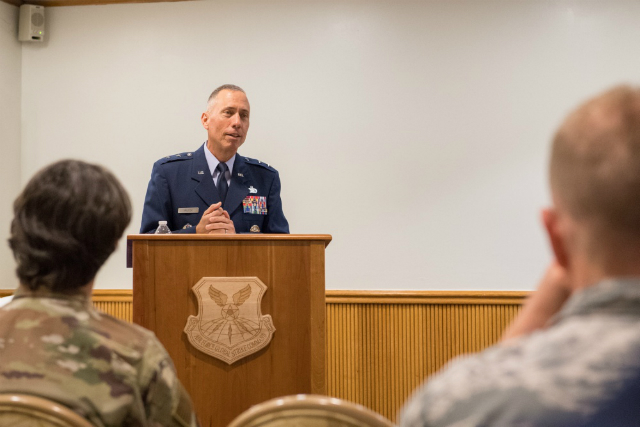
Maj. Gen. Tom Wilcox, Air Force Installation and Mission Support Center commander, addresses a crowd gathered for the AFIMSC Detachment 10 change of command ceremony at Barksdale AFB, La., September 4, 2019. Col. Wade Lawrence relinquished command of the detachment to Col. Martin Pantaze. Air Force photo by SrA Tessa B. Corrick.
The Air Force Installation and Mission Support Center, a key part of the service’s disaster response effort following hurricanes and other crises, is making tweaks to help USAF bases move forward faster.
Created in 2015, the center’s job includes connecting those affected by crises to others within the service that can address everything from family assistance to immediate cleanup to long-term construction. It launched the Tyndall AFB, Fla., Program Management Office in the aftermath of last year’s Hurricane Michael to oversee the rebuild effort, and has grown closer to the major organizations that make up the Air Force since its inception.
“When [Hurricane] Dorian came this time, we have a crisis action team that stands up at IMSC, and we have [detachment] commanders in each of the 10 [major commands],” AFIMSC Commander Maj. Gen. Tom Wilcox told Air Force Magazine on Sept. 17. “Those Det. commanders are now part of those MAJCOM crisis action teams, and they sit in there 100 percent to have that interface and be able to bring everything back.”
AFIMSC also stays in touch with a Washington, DC-based crisis action team. The center is putting together an initial response team of nine or 10 people who could work with a MAJCOM to evaluate what the organization needs in the aftermath of an emergency or disaster.
“We found after [Hurricane] Michael that we had to put two or three task forces together,” Wilcox said. “If we can lean forward on that, and have that team identified and be ready to go and say, “Hey, you got it for this month, you got it for this month, you got it for this quarter, we can plan around it,’ then all we’ve got to do is call those folks, get them on a plane to go.”
That response team would be key to helping installations and their residents work through the myriad to-do list that accompanies disasters. The team would inspect bases with wing leaders who know the area best, then connect the locals with builders, security forces, contracting, and other services.
“The installation is evacuated and all those folks are watching their families,” Wilcox said. “Then they’ve got to get their families back to the base, or they have to leave their family to drive back to the base. There’s a lot of stuff with paying airmen, travel vouchers and evacuation vouchers and all that.”
For example, the credit cards airmen use to pay for travel could need their limits raised because they’ll be away from home for longer than expected, among other issues people wouldn’t know to consider. That’s AFIMSC’s job, he said, using response checklists created thanks to Hurricane Michael, the Category 5 storm that pummeled Tyndall nearly one year ago.
The Tyndall PMO has issued $290 million in operations and maintenance restoration contracts in fiscal 2019 and plans to ink another approximately $25 million early in fiscal 2020, according to slides from a Sept. 12 industry day. Officials said they are battling shifting facilities requirements that complicate and drag out the contracting process, as well as a stretched-thin labor market in the local area, and having to split funding for its multibillion-dollar plan with flooded Offutt AFB, Neb.
AFIMSC is helping rebuild Tyndall to house the F-35 and, possibly, the MQ-9 in the 2020s. Its multi-campus plan aims to make the base more flexible for operations and resilient for future storms.
Overall, Wilcox appears satisfied that the center has all it needs to assist other airmen. He noted that AFIMSC can front some money to bases to prepare for big events, like it did for Patrick AFB, Fla., which Hurricane Dorian recently grazed. The center expects to get those funds back from bases later.
“I think we have a lot of the budget flexibility, initially. If it’s a large [event], like Michael, obviously we need congressional help on the supplementals to get after that,” Wilcox said. “It looks like they’re going to do it again next year, and then the stable funding over the next year or so to continue to rebuild that back. So I think we have the capacity there as a service of DOD.”
